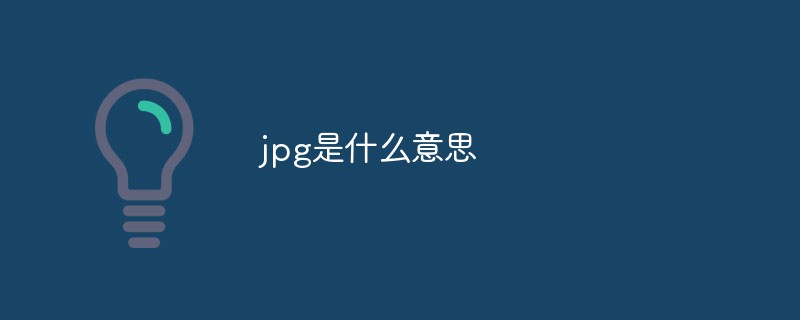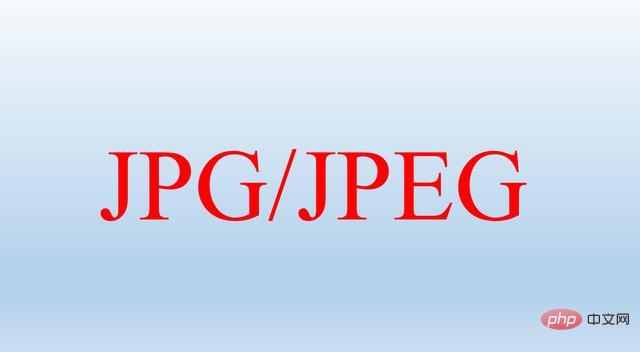Home >Common Problem >What does jpg mean?
What does jpg mean?
- 青灯夜游Original
- 2022-11-28 09:46:42133977browse
JPG generally refers to the JPEG format, which is an image format saved using a lossy compression method. It is a standard for continuous tone static image compression. Its file suffix is ".jpg" or " .jpeg". JPG files mainly use a joint coding method of predictive coding (DPCM), discrete cosine transform (DCT) and entropy coding to remove redundant images and color data; it can compress images in a small storage space, but to a certain extent will cause damage to the image data.

The operating environment of this tutorial: Windows 7 system, Dell G3 computer.
JPG (jpg) generally refers to the JPEG format, which is a product of the JPEG standard. This standard was formulated by the International Organization for Standardization (ISO) and is a compression standard for continuous-tone still images. JPEG format is the most commonly used image file format, with the suffix .jpg or .jpeg.
JPEG is an image format saved using a lossy compression method. As a result of compression, the output image cannot compromise both quality and size. Users can adjust the compression level to achieve the desired quality level while reducing storage size. If you apply 10:1 compression to an image, the impact on image quality is negligible. The higher the compression value, the greater the degradation of image quality.

JPEG (Joint Photographic Experts Group) is a standard for continuous tone static image compression. The file suffix is .jpg or .jpeg , is the most commonly used image file format. It mainly uses a joint coding method of predictive coding (DPCM), discrete cosine transform (DCT) and entropy coding to remove redundant images and color data. It is a lossy compression format, which can compress images in a small storage space. Space will cause damage to image data to a certain extent. In particular, using an excessively high compression ratio will reduce the quality of the image recovered after final decompression. If you pursue high-quality images, it is not advisable to use an excessively high compression ratio.
JPEG can use lossy compression to remove redundant image data and obtain better image quality using less disk space. Moreover, JPEG is a very flexible format that has the function of adjusting image quality. It allows files to be compressed with different compression ratios and supports multiple compression levels. The compression ratio is usually between 10;1 and 40;1. The higher the compression ratio, the higher the compression ratio. The larger the compression ratio, the lower the image quality; conversely, the smaller the compression ratio, the higher the image quality. For the same image, files stored in JPEG format are 1/10~1/20 of other types of files, usually only a few tens of KB, and the quality loss is small and basically invisible. The JPEG format mainly compresses high-frequency information, retains color information well, and is suitable for use on the Internet; it can reduce the transmission time of images and supports 24-bit true color; it is also commonly used in images that require continuous tone.
JPEG format can be divided into three formats: standard JPEG, progressive JPEG and JPEG2000.
1. Standard JPEG format; this type can only display images from top to bottom when downloading a web page. Only when all image data is downloaded can the full image be seen.
2. Progressive JPEG; when downloading a web page, this type first presents a rough appearance of the image, then slowly presents the complete content, and saves it as a progressive JPG The files in this format are smaller than those saved in the standard JPG format, so if you want to use images on a web page, you can use this format more often.
3. JPEG2000; it is a new generation of image compression method with higher compression quality and can improve the mosaic phenomenon and positional dislocation that are often caused by signal instability during wireless transmission. situation and improve the quality of transmission.
The advantages of JPG (JPEG) are:
It supports extremely high compression rates, so the JPEG image The download speed is greatly accelerated;
It can easily handle 16.8M colors and can reproduce full-color images well;
In the right During the image compression process, this image format allows you to freely choose between the smallest file size (lowest image quality) and the largest file size (highest image quality);
This format The file size is relatively small and the download speed is fast, which is conducive to transmission when the bandwidth is not "rich".
The disadvantages of JPG (JPEG) are:
Not all browsers support converting various JPEG images Insert into a web page;
When compressed, the quality of the image may be lost, so it is not suitable to use this format to display high-definition images.
JPEG is impressive with its low complexity and longevity. The following are the several levels given by JPEG as criteria for measuring the compression encoding effect for images of moderately complex images at 8 bits/pixel:
0.25 bits/pixel~0.5 bits/ Pixel; Medium ~ Good, enough for some applications;
- ##0.5 bits/pixel ~ 0.75 bits/pixel; Good ~ Very good, enough for many applications;
0.75 bits/pixel ~ 1.5 bits/pixel; excellent, sufficient for most applications;
1.5 bits/pixel ~ 2.0 bits/pixel; difficult Different from the original image, it is enough to meet most applications;
>2.0 bits/pixel; almost perfect, it can meet almost all applications.
The bit/pixel (bit/pixel) is defined as the total number of bits in the compressed image (including the chroma component) divided by the number of samples of the luminance component.
For more related knowledge, please visit the FAQ column!
The above is the detailed content of What does jpg mean?. For more information, please follow other related articles on the PHP Chinese website!

